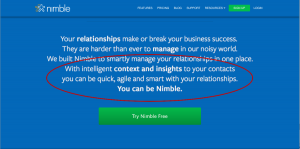— September 4, 2019

rawpixel / Pixabay
It all starts with CEO commitment.
Customer experience professionals got an early Christmas present last week in the form of a revised statement on the “purpose of a corporation.” Well, it was a revision for the CEOs at the Business Roundtable, but many of us already know what the purpose of a business is.
So, all I can say is, “It’s about time.” Why has it taken this long for these business leaders to realize that caring for employees and creating value for customers translates to greater value for shareholders. It’s called being customer-centric. It’s called customer-driven growth. (Both of which require you to put employees first, ensure that vendor and partner experiences and relationships are strong, and that any change initiatives or improvements are linked to business outcomes.) It’s what businesses are all about: all about the customer. If you don’t have any customers, you’re really not a business, are you?
Every time I’ve spoken at an event or presented on a webinar over the last I-don’t-know-how-many years, I’ve started with a Purpose of Business slide. That slide always contains Peter Drucker’s definition: to create and to nurture a customer. In order to do that, you need to put people ahead of profits (profits are outcomes, and the people will get you there) and be people-centric, not profit-centric. Doing so shifts the culture, the conversation, and the outcomes.
There are five tenets (below) as part of the new purpose statement signed by 181 CEOs of American corporations who are committing “to lead their companies for the benefit of all stakeholders – customers, employees, suppliers, communities, and shareholders.” The new purpose is to “create an economy that serves all Americans.”
- Delivering value to our customers. We will further the tradition of American companies leading the way in meeting or exceeding customer expectations.
- Investing in our employees. This starts with compensating them fairly and providing important benefits. It also includes supporting them through training and education that help develop new skills for a rapidly changing world. We foster diversity and inclusion, dignity and respect.
- Dealing fairly and ethically with our suppliers. We are dedicated to serving as good partners to the other companies, large and small, that help us meet our missions.
- Supporting the communities in which we work. We respect the people in our communities and protect the environment by embracing sustainable practices across our businesses.
- Generating long-term value for shareholders, who provide the capital that allows companies to invest, grow and innovate. We are committed to transparency and effective engagement with shareholders.
Unfortunately, they provide no information on how these tenets will be converted into action, nor do they offer a roadmap for how to get to full commitment (read: action) for each of these companies (and others who hopefully jump on the bandwagon).
What are these business leaders going to do to ensure employees are cared for and customer value is created? How will they spread the word and get their colleagues (there are more than 181 corporations in this world!) who didn’t sign this statement to get on board? What steps will they take to ensure there’s a strategy in place that delivers on these tenets for employees, customers, partners, vendors, and shareholders?
What’s a CEO to do? Well, the hard part is done, right? We’ve got her commitment. Now she’s just got to shift the mindsets, the behaviors, and the culture of the organization!
Ideally, she’s the customer champion in and across the organization but to really put her money where her mouth is, she’ll hire a Chief Customer Officer to orchestrate the transformation and to unite the rest of the C-suite on the work that lies ahead. (Some of the 181 companies do have CCOs.)
Next thing to look at is the current culture; we know that culture is values plus behavior. It’s time to take a look at the values to ensure that they reflect the people-centric culture that she’s trying to create. And then she’s got to make sure that acceptable actions and behaviors are outlined for each value. She then needs to model the behaviors and recognize and reinforce the same behaviors for her employees. McKinsey found that “transformations are 5.3 times more likely to succeed when leaders model the behavior they want employees to adopt.” (I’ve seen other stats that say that when modeling behaviors is combined with reinforcing them, you’re that much more likely to be successful.) McKinsey also found that about 50% of employees say that the most-effective action for engaging them in the transformation is a CEO who is herself visibly engaged and committed to the transformation. Makes sense.
Your CEO has also got to modify her communications. The dialogue must change. First, the things she talks about most are the things deemed important by employees. Second, she can’t talk about the change but continue to reinforce the same old way things have been done. A great example of this is a continued push or focus on “making the numbers.” Yes, this is important, but the numbers cannot be the first and only thing she talks about. (And when she transforms the business to be people-centric, the numbers will come!) She must talk about how employees and customers are impacting the business. She must bring the customer into discussions, decisions, and designs. She must talk about how the business is impacting all of its stakeholders – employees, customers, vendors, community, and shareholders.
And she’s got to update her metrics; they’ve got to evolve and/or shift order. Employee and customer metrics need to be added (if they aren’t on the dashboard/scorecard yet), and they need to be the first metrics that get reviewed and discussed by executives and managers alike. Measure what matters. Manage what gets measured. Measure to know success.
Obviously, there’s a lot more work that needs to be done, but I think those are some of the key things to get started with. In the past, I’ve laid out the building blocks for transformation success. The foundational blocks outlined in that post will all need to be in place for this to work. Feel free to share that graphic or that post with your executives.
Need to hear from some CEOs who have achieved people before profits success? Check out:
- Hal Rosenbluth’s The Customer Comes Second
- Bob Chapman’s Everybody Matters
- Garry Ridge’s Happy Billion Dollar Business
- Hamdi Ulukaya’s Anti-CEO Playbook
One final thought, a bit of a sidebar but related. When I see research that claims that “competing priorities” are the top obstacles to customer experience transformation efforts, I scratch my head and wonder, what could those competing priorities possibly be? What competes with customers for your business? What competes with customers for your resources and efforts? Isn’t it all about the customer? The interests of all parties should not compete – they work together, in sequence, as outlined in the Service-Profit Chain (a concept that’s been around for 30 years). Start with the employee, care for her and treat her well, and she’ll do right by the customer, by your partners, and by your vendors – and the business will benefit, as will shareholders.
OK, one more final thought! Will the management books used in our colleges and universities be updated to reflect this “new” purpose? I hope so. This conversation needs to start long before anyone even enters the business world.
If you work for one of these 181 corporations, I’m curious: What have you heard from your CEO in the week or so since this new purpose statement was issued? Crickets? Or the start of a plan to make this a reality?
A vision without a plan is just a dream. A plan without a vision is just drudgery. A vision with a plan can change the world. -Old Proverb
Business & Finance Articles on Business 2 Community
(16)





